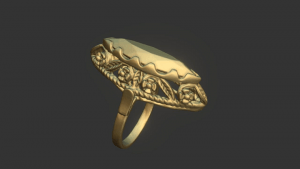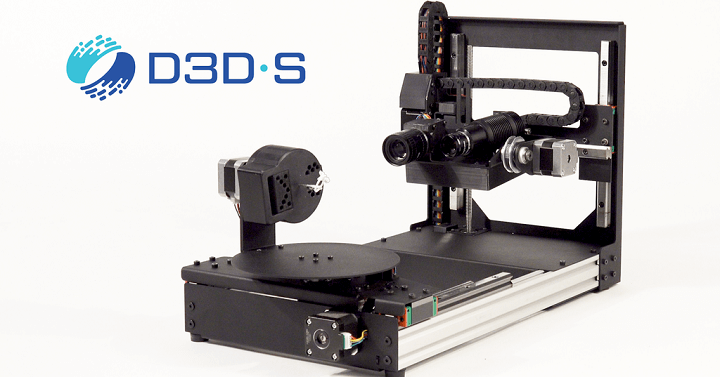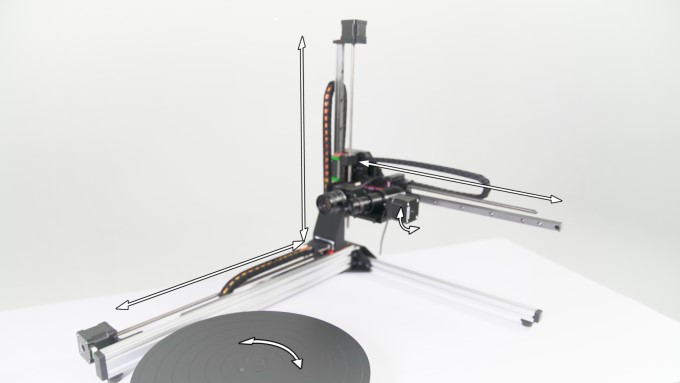Ukrainian company D3D-s was founded four years ago by father and son team Leonid and Denys Nazarenko, and last year they successfully raised $250,000 through Kickstarter for their first desktop 3D scanner. The duo built the structure, and the accompanying software, for their highly accurate scanner from scratch, and are now in the middle of another crowdfunding campaign for a jewelry LED-line desktop 3D scanner that promises retina resolution for even large models.
“Our D3D-s scanner takes advantage of LED-line technology, combining incredible accuracy and a price you can afford. Our sophisticated software achieves exceptional results when scanning jewelry,” the Kickstarter campaign page reads.
 Most 3D jewelry scanners use projection technology, which typically requires components like projectors and cameras that are by no means affordable to the average amateur consumer or self-employed jeweler. The Nazarenkos list, for example, the B9 Scan350 jewelry projection scanner, which offers only two motion directions, a 1.3 MP camera, and costs a hefty $15,000. But the new D3D-s scanner uses a high-quality 5MP resolution camera and an inexpensive LED projector, which offers six motion directions, emits only one line, and is available to Kickstarter backers for just $4,000 – still expensive by my standards, but definitely a much more reasonable cost.
Most 3D jewelry scanners use projection technology, which typically requires components like projectors and cameras that are by no means affordable to the average amateur consumer or self-employed jeweler. The Nazarenkos list, for example, the B9 Scan350 jewelry projection scanner, which offers only two motion directions, a 1.3 MP camera, and costs a hefty $15,000. But the new D3D-s scanner uses a high-quality 5MP resolution camera and an inexpensive LED projector, which offers six motion directions, emits only one line, and is available to Kickstarter backers for just $4,000 – still expensive by my standards, but definitely a much more reasonable cost.
The company’s website explains how it was able to achieve this feat:
“The scanner is made of parts that are used in 3D printers and can be purchased one piece at a time. Only a few parts, such as the projector, mount, etc., are manufactured to order in small batches. Thus, we don’t have to make a huge batch of scanners. This significantly reduces our costs and investments.”
The D3D-s is a turntable 3D scanner, and its vertical accuracy reaches 0.010 mm, with a 0.015 mm horizontal accuracy, which is very helpful in terms of discerning small details on jewelry. Its moving step resolution is 0.000625 mm – over 84 times the resolution of projection scanners. According to a press release from the company, developers actually had to “limit the maximum resolution in order to get clients a finished result within 7 minutes.”
The scanner’s external dimensions measure 600 x 300 x 420 mm, and it weighs about 10 kg. It uses Windows software, LED light 945 Luminous Flux (lm), and 2 x USB 3.0 connectivity. It is a mono-color 3D scanner, and while the scanning process is fully automated, a computer connection is required for autonomous scanning.
 The D3D-s scanner had electronics specifically developed for its use, with a four-layer circuit board that efficiently distributes heat and an electric motor controlled by a L6472PD microcontroller, which makes it possible for the scanner to smoothly accelerate and slow the motor. Once you select the size of your scan and click the button, it’s smooth sailing, and you’ll get an accurate STL file at the end. Due to refined algorithms and mathematics, jewelers can successfully achieve a precise, highly accurate 3D model; to see some examples, check out D3D-s on Sketchfab.
The D3D-s scanner had electronics specifically developed for its use, with a four-layer circuit board that efficiently distributes heat and an electric motor controlled by a L6472PD microcontroller, which makes it possible for the scanner to smoothly accelerate and slow the motor. Once you select the size of your scan and click the button, it’s smooth sailing, and you’ll get an accurate STL file at the end. Due to refined algorithms and mathematics, jewelers can successfully achieve a precise, highly accurate 3D model; to see some examples, check out D3D-s on Sketchfab.
One thing the D3D-s doesn’t offer is speed, but the company doesn’t think this is too big of a problem:
“Our scanner is one of the slowest in the world, but it will make you one of the fastest people! It does your work for you. You simply put the model on the table and that’s it. You can work on something else while you leave the D3D-s to handle all the hard work. No other scanner offers such luxury! Scanning with amazing accuracy, the D3D-s processes a huge amount of data and isn’t as fast as other less refined scanners. That said, it is more accurate and thorough than handheld scanning. Let the scanner scan!”
Did you know that for microscanning even temperature has an effect? This how we test it. pic.twitter.com/WojYpS0RLE
— D3D-s (@d3d_s) July 11, 2019
There are still over two weeks left in the Kickstarter campaign for the new D3D-s scanner, and the company has already raised over half the necessary funds. There are still some early bird rewards left as well. With its last crowdfunding campaign, D3D-s fulfilled its original commitment to the Kickstarter backers, and even went above and beyond by providing an updated USB 3.0 camera and advanced scanner body with new electronics. So if you’re in the market for a slow but accurate, less expensive jewelry 3D scanner, the D3D-s may be what you’re looking for.
Discuss this and other 3D printing topics at 3DPrintBoard.com or share your thoughts in the Facebook comments below.
Subscribe to Our Email Newsletter
Stay up-to-date on all the latest news from the 3D printing industry and receive information and offers from third party vendors.
Print Services
Upload your 3D Models and get them printed quickly and efficiently.
You May Also Like
3D Printing News Briefs, July 2, 2025: Copper Alloys, Defense Manufacturing, & More
We’re starting off with metals in today’s 3D Printing News Briefs, as Farsoon has unveiled a large-scale AM solution for copper alloys, and Meltio used its wire-laser metal solution to...
3DPOD 260: John Hart on VulcanForms, MIT, Desktop Metal and More
John Hart is a Professor at MIT; he´s also the director of the Laboratory for Manufacturing and Productivity as well as the director of the Center for Advanced Production Technologies....
3D Printing News Briefs, June 28, 2025: Defense Accelerator, Surgical Models, & More
In this weekend’s 3D Printing News Briefs, 3YOURMIND was selected to join an EU Defense Accelerator, and PTC has announced model-based definition (MBD) capabilities within Onshape. Finally, a study out...
EOS in India: AM’s Rising Star
EOS is doubling down on India. With a growing base of aerospace startups, new government policies, and a massive engineering workforce, India is quickly becoming one of the most important...



































